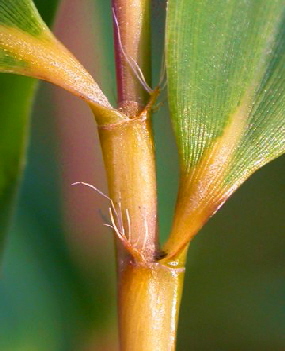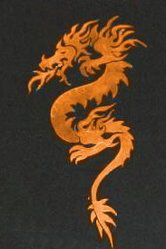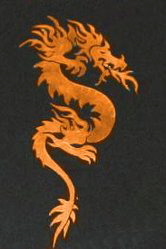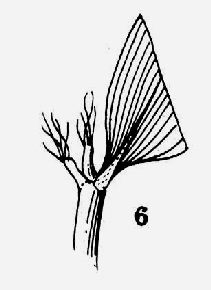 |
|
Illustrations of Fargesia dracocephala in the Chinese literature, which may be somewhat stylised and drawn without magnification, make it quite clear that the real species has very prominent and distinctive leaf sheath auricles, see below. It
From the description of Fargesia dracocephala in the new Flora of China bamboo account, and the illustrations in the Chinese version and elsewhere, there can be no doubt that the bamboo cultivated as Fargesia dracocephala in western horticulture for about 15 years cannot actually be F. dracocephala at all. It was collected from Daba Shan in Shaanxi Province in 1987 by Jiong Lin Lu for cultivation in Germany by Max Riedelsheimer. Max saw a similarity to the description of F. dracocephala, and sent specimens to China, where it was agreed that it should be identified as F. dracocephala. It flowered and seedlings were widely distributed in the early 1990s, but this species has no auricles or setae at all on its leaf sheaths, so F. dracocephala cannot be the correct name. However, we do have a bamboo in cultivation with just such oblong leaf sheath auricles, introduced from Gansu in 1995, and grown under the names Gansu 95-1, Fargesia rufa, and Fargesia sp. ‘Rufa’. From the text of the Flora of China there would appear to be only 2 species of Fargesia with oblong leaf sheath auricles, and only one from Gansu: Fargesia dracocephala. The other characteristics given in the description match Fargesia sp. ‘Rufa’ fairly well, given that the culm sheaths from which the description was drawn up might have been rather old. It would be necessary to see the actual holotype of this species, collected by T. P. Yi in 1975 in Nanjiang Xian, N Sichuan
Why was it called rufa and not dracocephala?Jos van der Palen has documented the introduction of this bamboo. It would seem that he actually wanted to identify it as F. dracocephala but felt that he could not do so, as that name was already being applied to a different, previously introduced bamboo, grown under that name. From the description of Fargesia rufa, in which it is stated that it has no leaf sheath auricles at all, it would not appear that identification of this species as F. rufa is strongly supported.
The time has now come to identify this bamboo as F. dracocephala ‘Rufa’, and that is how it will appear in the ABS Species & Sources List from 2007. Because of the deliberate use of the name Fargesia sp. ‘Rufa’ without assuming the species in the horticultural trade, and continuing the connection to the name rufa under which it was first grown, this is less of a change than it could otherwise have been. Unfortunately we are still left with a major change for the bamboo which had been inaccurately identified as Fargesia dracocephala for so long. That bamboo has now been described as a new species, Fargesia apicirubens, because of the reddening (rubens) of the tops (apici) of the new shoots, the leaf sheaths, the culm sheaths, and the culm internodes.
|
||||||||||||||||||||||||||||||||||||||||||||||||||||||||||||||||||||||||||



